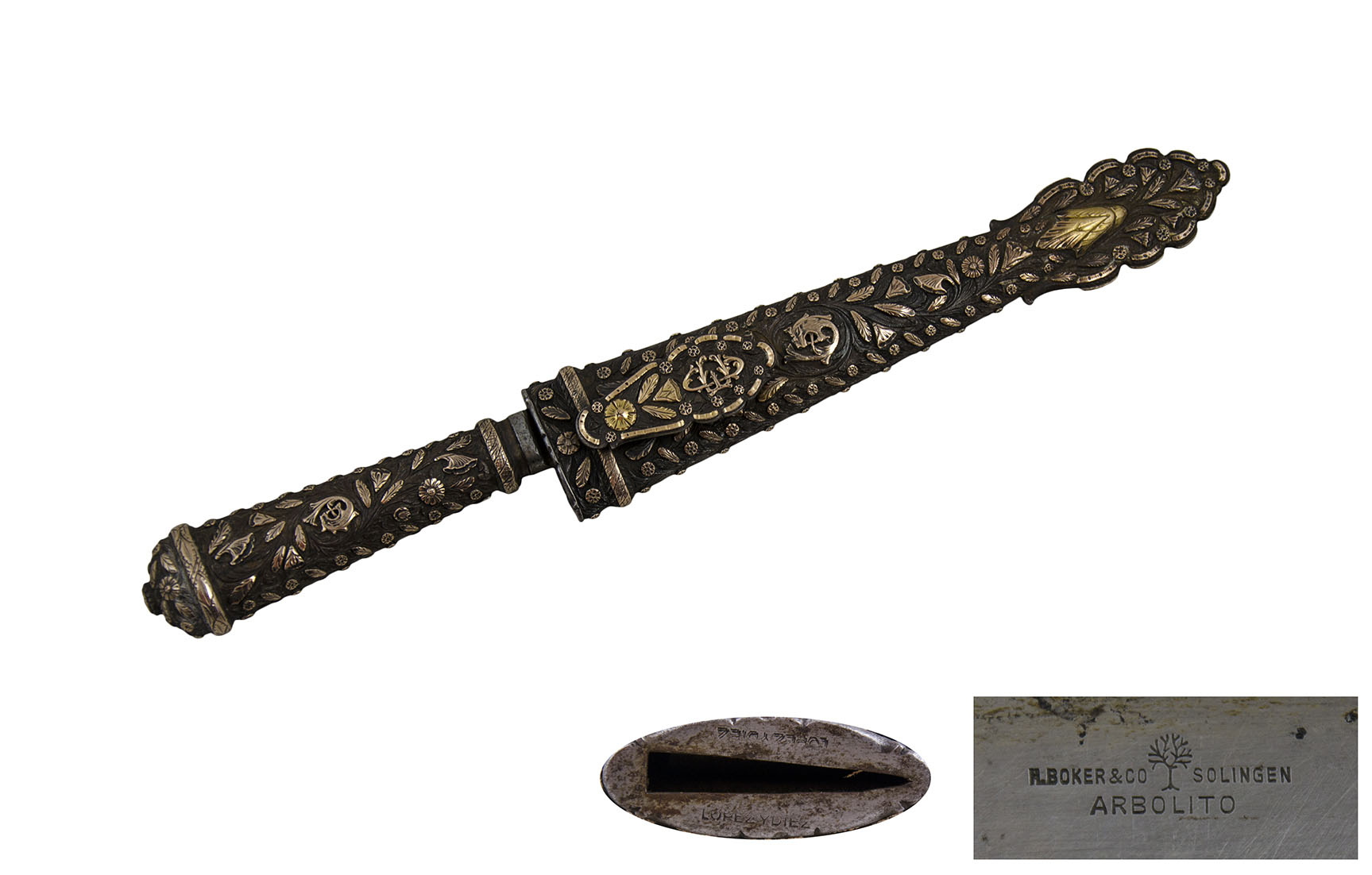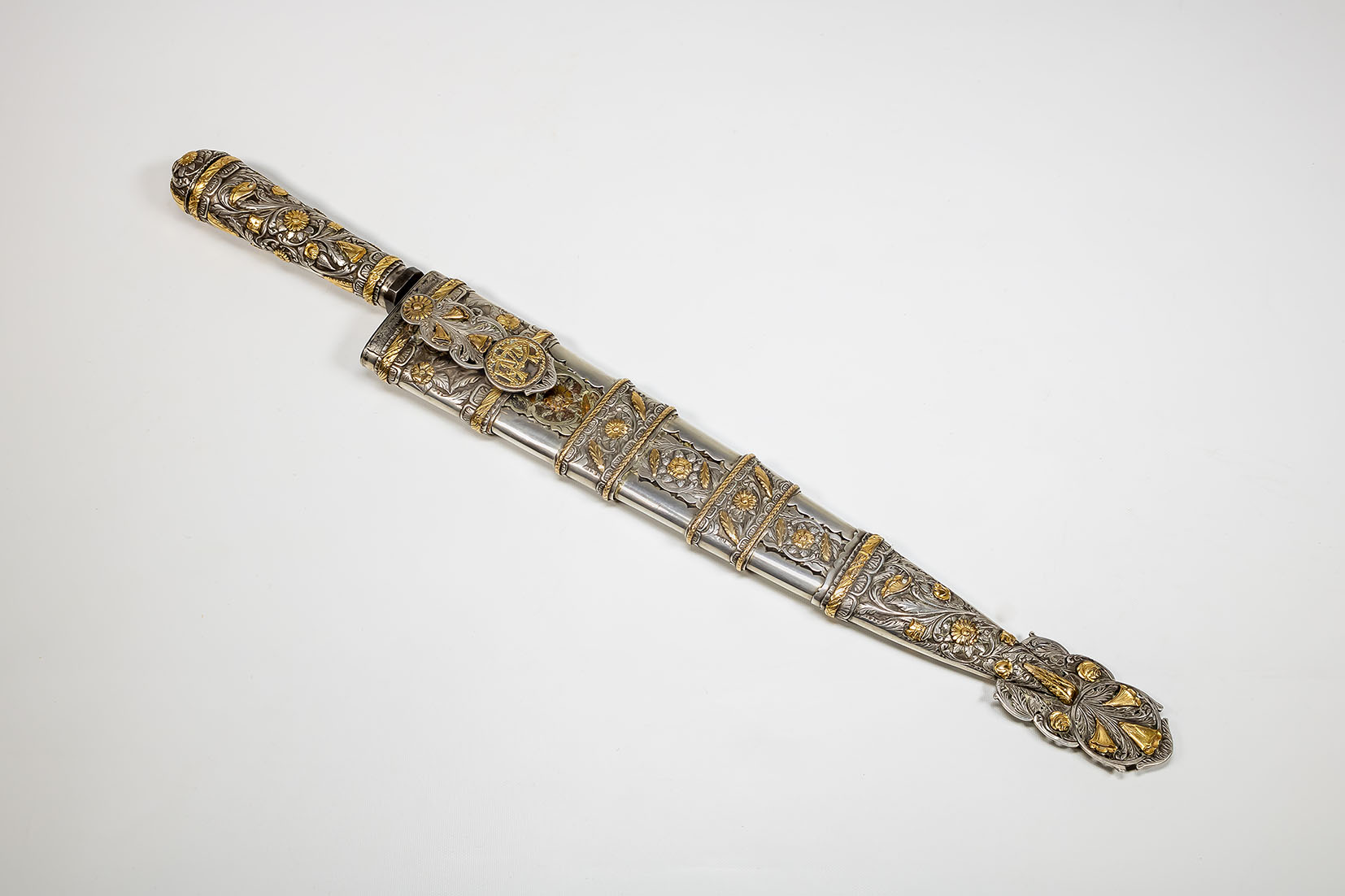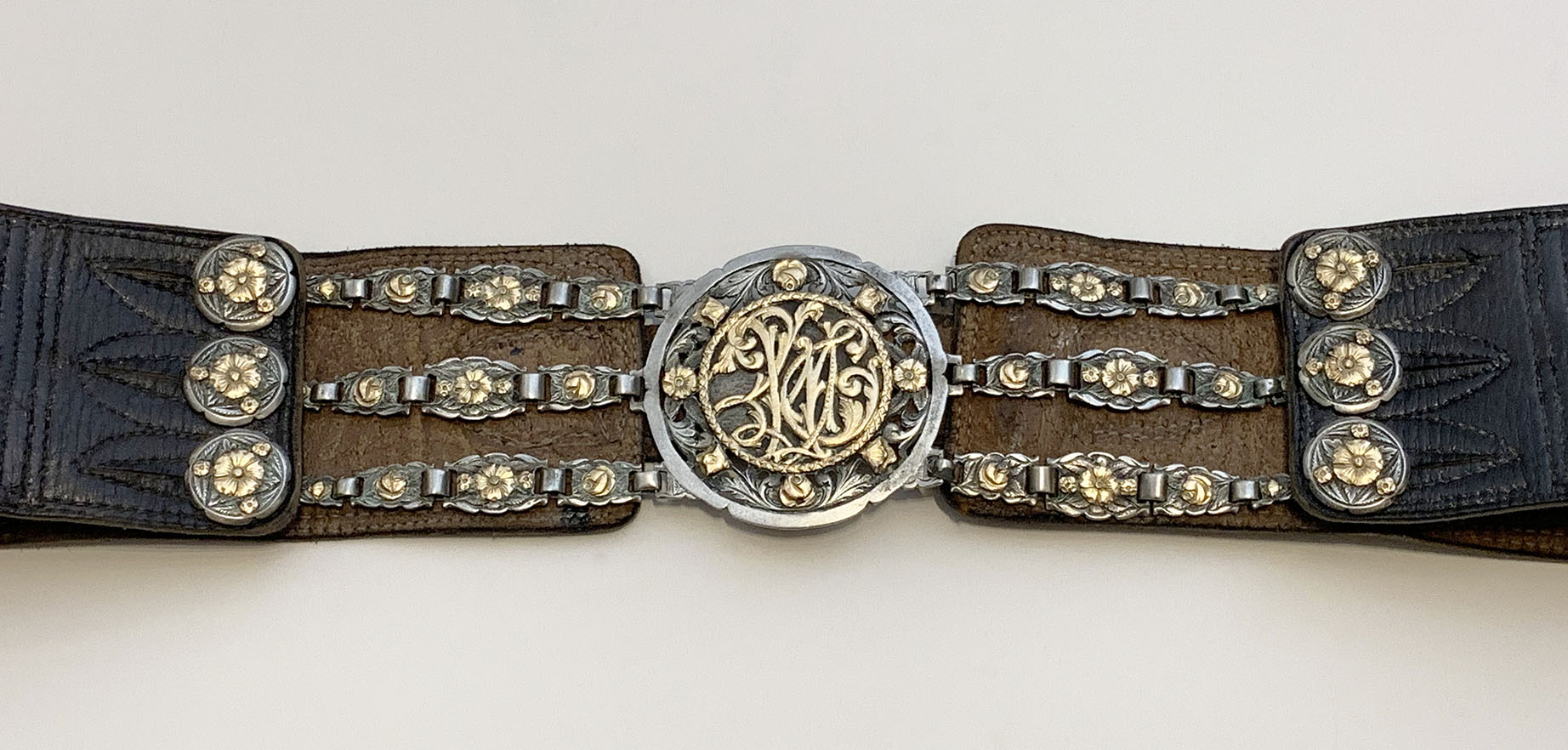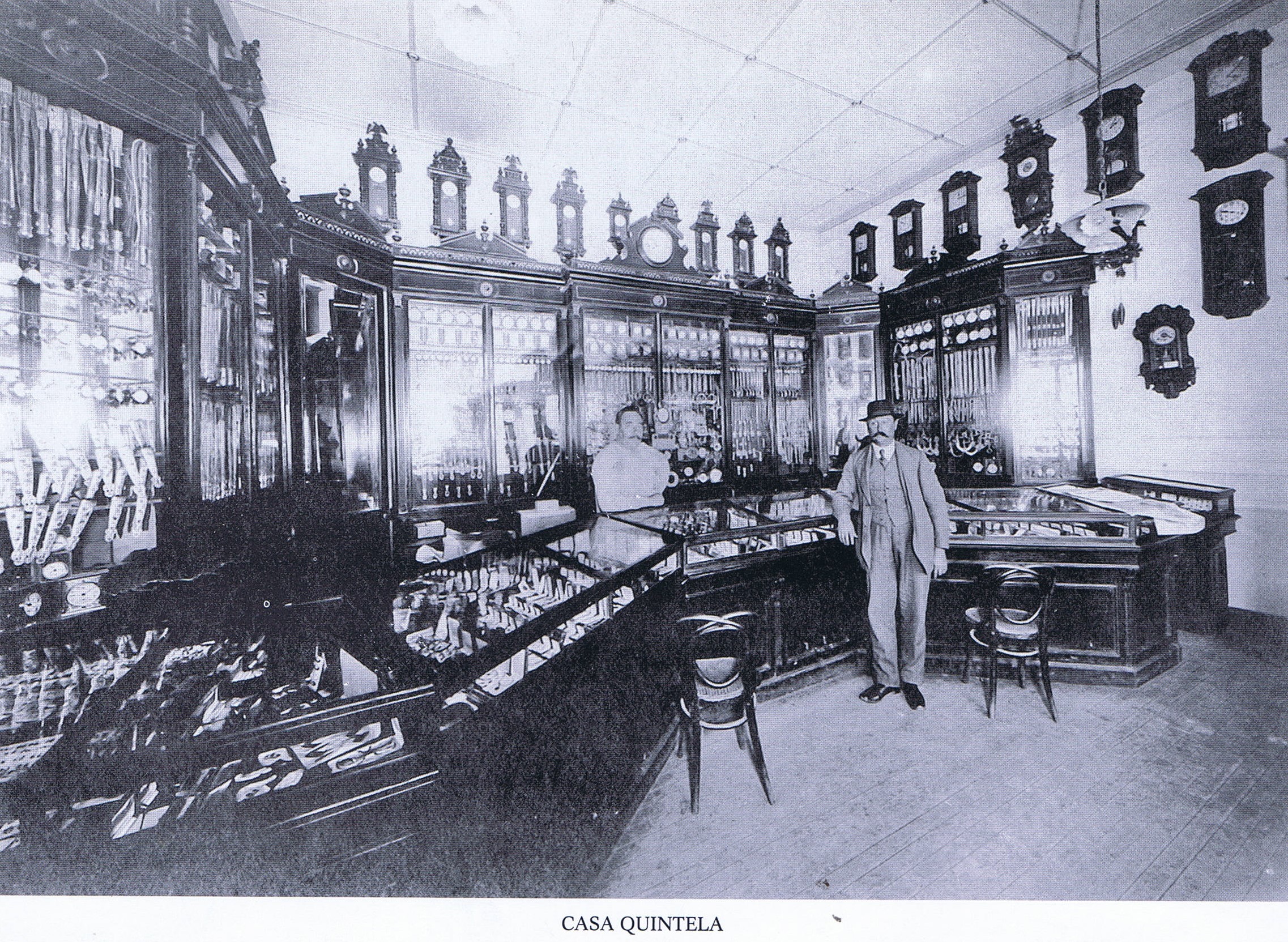Born in 1898, his full name was Carlos Justo López, but hearing loss gave him his authentic identity, "El Sordo López", today so recognized through his pieces. Being an exceptional chiseler, he specially made knives, harrows and handles with a unique decorative repertoire, which he also knew how to apply in some "veneers" that aroused admiration among the public in parades and contests of undertakings, archetypes of the so-called errands of the coast, heterodox version of Creole horsemanship born in the 20th century, not accepted by the traditionalists most attached to the old ways.
His masterful application of chisels, exuberance of a unique art - with similarities and differences to the mastery that Dámaso Arce converted into the Olavarrian style - made his life story a myth. With very few biographical references, his time in Necochea and Tres Arroyos is known, in that associated with Diez, as indicated by the punch with which he sealed the pieces created at that time: López y Diez. And from these precise data, although without chronological detail, the rumors lead to drastic situations, such as: "he arrived in Tres Arroyos fleeing a death, and in that Buenos Aires city he sought to hide; This explains why he did not sign his pieces. For others the problem was a gambling debt, and there are also those who maintain that the reason for the move turned out to be a fight with a daughter.
Always motivated to know the lives of our master craftsmen, we set out to trace their past, ready to navigate that sea of doubts. And the journey became fascinating, even seeing eyewitnesses. An investigation that remains open, but that already gives us the possibility of sharing information hitherto unknown, although there are areas not yet revealed.
In “prehistory”
Without verifiable data, they tell us that he was born in the district of Tres de Febrero -in Greater Buenos Aires- and Perico Medina, the Tresarroyense silversmith, remembers that his teacher and disciple of López himself, Juan Francisco Soriano -Pancho-, commented that He had learned to work with metals in a bronze statue casting workshop in Buenos Aires, where he made the chiseled details.
In our list of silversmiths - research work that we began more than twenty-five years ago - we have a reference that is worth mentioning: "advanced disciple of Bernardo Delgado, silversmith from Tres Arroyos." [1] Perhaps he had his training as a chiseler, as Pancho Soriano claimed, but not as a silversmith, and in Delgado's trade he learned the secrets of the trade, which in harmony with his mastery of chisels resulted in an unmistakable style. We confirmed this idea by notifying us that Delgado was not a silversmith, but rather the owner of a firm that, among other things, had a silverware section. With such a strong demand in those years, he must have had an official silversmith, responsible for the commissioned works and, in addition, author of a good part of the pieces exhibited in his business. If our hypothesis is correct, he would have taught López and the phrase “he learned with Delgado” should adjust to “he learned in Delgado's house.”
The truth is that, closely linked to this city, he was also related to Francisco Quintela, owner of a prosperous jewelry and watch business, called La Argentina [2], founded in 1897. Quintela knew how to serve an important network of clients that extended through this rich rural area.
Without very firm clues, we are inclined to think that in the forties of the last century he already frequently went to Tres Arroyos, where he had established commercial ties with the owners of the punches that distinguished this city at that time: Delgado and Quintela. He perhaps traveled frequently by train and in this Buenos Aires city he took orders and delivered jobs. Already in the following decade we find him settled in Necochea. This is what one of our interviewees tells it, Marta, wife of Julio Ordoqui, who knew how to parade with the barrette undertaking that, Don Ángel, her father, had commissioned from Sordo López.
In Necochea
Marta Biscaysaqu, from Necochea, remembers that her father-in-law - accompanied by her husband - entrusted him with the errand in the 1950s; At that time, López had his workshop on the first floor of her daughter's home in the spa city. And in the conversation he surprises us with a hitherto unknown story: years before he had gone through a crisis, he had become a walker, a croto... «His daughter rescued him, and together with her husband they set up his workshop on the upper floor of home". At that time he signed his pieces with the brand LOPEZ Y DIEZ, and even indicated on many, NECOCHEA. Ten was his son-in-law, a man with good financial resources who knew how to help him.
Marta specifies that at that time she was linked to Delgado, from Tres Arroyos, and the message that her husband saddled - she indicates, noting that some very expensive undertakings were also the work of López - includes leather work made by Don Ángel Castiglioni, a rope maker. of that city, the provincial capital of Wheat. «López also made my husband the harrow and the facón –he says-, those were very important. Once we took them with my daughter to Juan Carlos Pallarols, in Buenos Aires, and he was shocked.
«Here in Necochea, two very important undertakings made by this silversmith are always mentioned; that of Coco Dindart and that of Ravelino, from Mar del Plata, a message that later passed into the hands of Dr. Illia from Benito Juárez. My husband paraded and participated several times in the Emprendado Festival, in Mar del Plata, organized by Héctor Decuy; Yes, he even won the first prize in the first edition. "We went for several years."
In Tres Arroyos
Willing to reveal so many mysteries, we traveled to Tres Arroyos and there we interviewed Marcela Díaz Balladares, who knew him a lot. Her story is assembled with Doña Marta's sayings and thus the veil that covered the biography of this enormous silversmith is removed.
«In the sixties – Marcela assures, supported by the memory of her mother – she arrived by train to Tres Arroyos [3], to work in Delgado's workshop, when he was on the corner of Chacabuco. and Lavalle. There he had his place, Talabartería El Sol, with two horses where he displayed the tools; Those horses had been made by ropemaker Ángel Castiglioni, they were not embalmed, nor made of fiberglass, like the ones you see now. López also brought his work already done, and took others... »
«My father-in-law had a place in front of the station, Marcela tells us, a frugal, tough man, but they became friends; He had a bar and an inn, and he used to stay overnight there [4], until, in 1964, he bought a house and soon after sold it to my parents. López was in a difficult situation, he had quarreled with one of his daughters and proposed that they buy the property and allow him to continue with the workshop; he would build a room to live there. It was a very difficult moment for López and my parents, he told them that if they didn't buy it he would throw himself under a train. In the deed of that sale - I looked at it last night -, surprisingly, there are no identity documents for any of them, and Don Carlos - that's what we called him - declared that he had been separated from Dominga Arce for thirty years. (5)
Verijero with exquisite chiseling work. The "López" punch raises a doubt: does it only carry his name since its origin, or did he modify it by eliminating "and Diez", as we have seen in other pieces? Particular collection.
«My mother -Derlis Ruth Balladares, like that with a long b- remembers that, when López referred to Diez, his son-in-law and older than him, he said “the old man this one”, although he had helped him and he did not forget that. Ten died and his daughter had a second husband, a military man. She never communicated to find out how her father was, my mother called her on the phone and told her... In 1980, a few months before I turned fifteen, they came looking for him and with a truck they took everything from the workshop - the rolling mill and the half cane too -, to the huge safe, where I kept the pieces in process, materials, drawings, photos... They also took the gold knife with an Arbolito blade that I had made for my mother. For me he was the grandfather of the heart. I remember him in his workshop, “The stove,” that's what he called it, and sitting in the kitchen playing solitaire and drinking tea before dinner. We had to yell at him, he was very deaf and didn't use a hearing aid. He made me a ring with gold applications, and he gave my sister a bracelet, like the one she had made for María Félix, with openwork links; I remember that among the scenes that he had chiseled was the hummingbird with the flower and a little countrywoman dancing with the handkerchief between her fingers and how beautiful, the dress with its folds.
"In the workshop, at home, he made the undertaking of Santos, of Bahía Blanca," he tells us. For our part, we add that we exhibited this message in the exhibition The gaucho and his knife, in the only existing cutlery museum in Spain, in Albacete. It was the astonishment of the visitors.
Always going to her mother's source - "when she is well, she remembers a lot," her daughter explains to us -, "I saw the photos, she sent Perón's message and she believes that she gave it to a religious man, Feliciano... no "Remember the last name."
In Tres Arroyos, it is clear from the testimonies presented, he worked in the business of Bernardo Delgado, who had a silversmith's workshop, and later, in his own space, in the workshop of his house where he did not count with helpers; He did everything alone, except for the leather work, which he entrusted to Castiglioni. And we have already announced it, he also worked for Francisco Quintela; Francisco Soriano entered as an apprentice here, when he was barely 14 years old, and became a disciple of this masterful chiseler. His time in this jewelry and silver shop is also attested to by a wonderful waist knife that bears his imprint and has the mark of this Tres Arroyense house, certain proof of that link. The Quintela House was headed by its founder until 1925, when he died, and was succeeded by his son, the original, Francisco Pancho Quintela (h).
As we understand it, Carlos López, the prominent Sordo López, started in silversmithing in Tres Arroyos and also in this city he produced his latest works, after having worked for some years in Necochea. Already in his eighties and away from the profession, he returned to this city and there he died, it is said, in 1988.
His horse track parade and compete
Among those that we have managed to reference, perhaps the oldest is the one he prepared for Víctor Aizpurúa in the 1940s. Later he made the one for Coco Dindart, a reserved trooper who knew how to show off with the undertaking that Sordo López created for him, a surprising “message from the coast”, very abundant in luxuries of silver and gold.
Coco Dindart shows off his finery in a traditional parade.
During those years he also built a venture that caused sighs, the one commissioned by Ravelino, from Mar del Plata, years later in the possession of Dr. Illía, from Benito Juárez. And as his wife confessed to us, the set of short pins from Ángel Ordoqui, from Necochea, all of them accompanied by the rider's clothing, in Ordoqui's case, with the facón and the harrow with his handler.
Already installed in Tres Arroyos, it is known that he assembled several, generally with the punch “B. Delgado” - surely, managers in this business - and others without a mark of authorship. And in his workshop in this city, he knew how to create another of the most luxurious, the one entrusted to him by Julio Santos, from Pedro Goyena, a town near Pigüé. «I saw Santos saddled with this message in 1975, in the parade organized in Coronel Pringles by the fort “El fogón de los gauchos”», Julio Biocca, a traditionalist from Bahia based in Tres Arroyos, tells us.
A luxury tandem: López and Castiglioni
Ángel Castiglioni (1913 – 1997) was a master of leather arts; The son of a carter, he learned the secrets of the rope maker and saddler's trade by “preparing” the harnesses and other straps that his father needed to make the journeys with the bags of cereal to the train station. «He worked since he was a child - now it is his daughter Betina who describes his life story to us - together with his father, my grandfather; He taught him the basics of leather and with great dedication he set up his own business - it was named after him, Talabartería Castiglioni [5], and it was in Hipólito Irigoyen y Solís, here in Tres Arroyos -, it was his passion; If I tell you that he worked until 1996, when he was in his eighties.
«I try to remember López, but no, it's impossible, I was very young. I remember, however, that as a child, smells caught my attention. My father's workshop was on a corner, and in the back, I'm talking about the years 1968 or 69, there was the place where a silversmith worked, I think I remember his name was Blas González... But I don't remember him.
«Tres Arroyos was a city that knew how to gather a significant number of horsemen wearing good clothes -it is now Julio Biocca who tells us-, and many came from that duo; although López not only resorted to the leathers of Don Ángel Castiglioni, who at that time used alum -except in the ties and in some other garments-, as indicated by fashion, and his rope was white.
Many of the orders arrived at Bernardo Delgado's house, a kind of general store, and those purchase commitments went to the López and Castiglioni workshops; Each one did their own thing and in the end, the one who started carried the punch “B. Slim". Some of them still distinguish their owners, generally traditionalist riders who seek to preserve the customs of the gaucho through their equestrian practices.
Notes:
1. Coinciding with this statement, Mrs. Marta Biscaysaqu, from Necochea, also recalled that she had learned with Delgado. She treated the famous Sordo López during her husband's lifetime.
2. Francisco Gerónimo Quintela, Spanish, arrived in the country as a minor, with a permit signed by his parents. His daughter, then in her eighties, told us more than twenty years ago that Francisco had had a relationship with Dámaso Arce, also from Spain. It is known that this enormous goldsmith landed in Buenos Aires in 1888 and that, living in Indio Rico, a town in that district, he moved to the head of the district, to the city of Tres Arroyos when he was barely 14 years old. There he began his trade in the Bagardi family jewelry store and, it is likely, some time later he worked with Quintela, settling in Olavarría in 1901.
3. Perhaps, he previously made train trips from Buenos Aires, as we indicated, and in the 60s, from Necochea he traveled by bus, since there was no railway branch that linked both Buenos Aires cities.
4. He could well have built that friendship on his railway trips and linked to this man, he continued to frequent him years later, when he was surely traveling by bus from Necochea.
5. Up to this point, mere coincidence. We consulted the direct family of teacher Dámaso Arce and we did not find Dominga's name in it.
6. César Soriano, jeweler, tells us that his grandfather, a saddler, Don Ramón Soriano, taught Ángel Castiglioni a lot about the trade. And the branches continue to intertwine...
Acknowledgments: Juan Miguel Arbuco, Marcela Balladares -and her mother Derlis Ruth-, Julio Biocca, Marta Biscaysaqu -and her daughter, Norma-, Betina Castiglioni, Segundo Deferrari, Andrés Errea, José Irastorza, Perico Medina, Andrés Muñoz and Osvaldo Quintela.



